Eye Vitamins & Supplement Recommendations for:
Dry Eyes: eye moisture comfort
Cornea: "white" of the eye
Eyelid / Membranes: lashes & glands
Eye Fatigue
Our fast paced life based mostly on close work, especially computers, is causing lots of problems for vision. Computer eye strain is the most common complaint to eye doctors today.
- Why your eyes get tired and what to do about it.
- Related conditions: asthenopia, computer vision syndrome and dry eyes.
Moisture Support
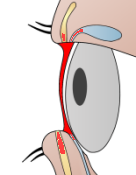
Comfort depends upon your eye retaining moisture. This function is supported by the three layers of the tear film: the mucous layer, the watery layer and the oily layer.
- How to keep your eyes moist and why it's important Dry eyes is one of the most common complaints, especially after menopause.
- Related conditions: Dry eye syndrome, Sjogren's syndrome, computer eye strain, and meibomian gland or lacrimal (tear) gland disfunction.
Corneal Support
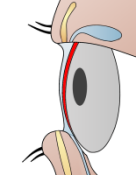
The transparent cornea not only protects the eye from foreign objects and water, but it absorbs oxygen and nutrients and actually provides 65% to 75% of the focusing capacity of the eye. It consists of a number of layers performing very precise functions.
- Learn more about the cornea and protecting corneal health.
- Related conditions: Fuch's dystrophy, keratoconus, allergies, ocular rosacea,
and ocular herpes.
Eyelid & Conjunctiva
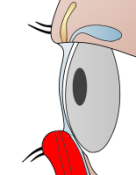
Inflammation of the eyelid and/or conjunctivitis can produce a number of common, mostly not too serious, conditions. However, if any of these conditions last more than a week or so you should see an eye doctor.
- How to keep your eyelids and conjunctiva healthy.
- Meibomian gland dysfunction
- Styes.
- Eye twitch
- Related conditions: pterygium, conjunctivitis, chalazion, eye infections, and blepharitis.
Health of the Lens

Changes to the eye's lens can result in cloudy, blurry vision, eventually limiting your ability to drive, read and see color.
- How the lens works and vitamins and supplements that support lens health and clarity. Cataracts are one of the most common side-effects of aging.
- Related conditions: Cataracts, diabetic lens osmosis, myopia, hyperopia, and presbyopia.
The Vitreous Humour
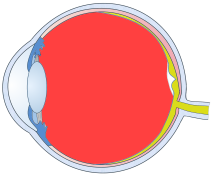
The vitreous (or vitreous humour) is a gel-like substance that fills the center of the eyeball maintaining a constant pressure to hold the shape of the eye. It can thin, shrink and clot with age leading to floaters and detachment from the back of the eye. Learn more about how to support the health of your vitreous.
- Support for vitreous floaters Usually only an annoyance, sudden increases in floaters can signal something more serious.
- Vitamins & supplements to keep the vitreous healthy Changes in the vitreous cause strain on the eye's connective tissue.
- Related conditions: floaters and vitreous detachment.
The Retina

The retina located at the back of your eyes is a layer of tissue that contains nerve cells, blood vessels, photoreceptor cells and other layers that help distribute nutrients to the eyes. Damage to the retina harms central and overall vision in a variety of ways. Learn more about how to support the health of your retina and over all eye health.
- Learn about vitamins & supplements that support the retina
- Photoreceptor damage - general damage to photoreceptors.
- Cone and rod damage - genetic mutations cause damage.
- Damage due to retinal sugar balance - a frequent additional problem for diabetics.
- Damage to retinal connective tissue - causing detachments.
- Retinal connective tissue hole - holes in connective tissue.
- Retinal damage involving vitamin A issues - worsened with vitamin A intake.
- The retina can wrinkle or pucker
- Related conditions: macular hole, macular pucker, diabetic retinopathy, retinitis pigmentosa, Usher syndromes, lattice degeneration, cone-rod dystrophy, night blindness, light sensitivity, retinal detachment, and Stargardt's disease.
The Macula
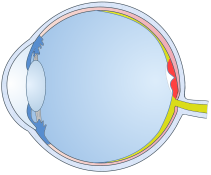
The macula is located at the back of your eye near the center of your retina. The macula enables central vision, the vision that enables you to make out details. It is essential in order to read and recognize faces. Learn more about how to support the health of your macula and retina and over all eye health.
- Vitamins & supplements that support macular health. Macular degeneration is the best known of problems involving the macula.
- Untreated macular damage can be severe.
- Learn about damage to the macula causing swelling Sometimes edema in eye tissue contributes to macular problems.
- Severe myopia with elongation of the eye can damage the macula.
- Related conditions: macular edema, myopic macular degeneration, wet/dry macular degeneration, and Best's disease.
The Eye's Vascular System

The choroid is the spongy layer next to the retina that supplies it with oxygen and nutrients along with other critical functions. This structure along with the vortex veins and retinal artery and retinal vein work together to protect and nourish the retina.
- Supporting the health of the eye's circulatory system. Occlusions in retinal arteries and veins cause serious damage to vision.
- Related conditions: central/branch artery occlusion, central/branch vein occlusion, ocular migraine, and central serous choroidopathy.
The Optic Nerve
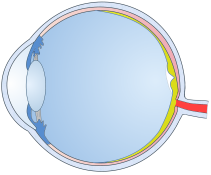
If the optic nerve is damaged by nutrient deprivation, trauma, compression from pressure, or other causes, vision is significantly impaired. Learn about lifestyle and nutrition to support the health of your optic nerve.
- Inflammation, trauma, deficiencies, toxic damage. Several examples: The optic nerve can become inflammed due to autoimmune or viral conditions resulting in optic neuritis. Nutritional deficiencies are tied to various optic neuropathies.
- Intraocular pressure. Untreated increased intraocular pressure (eye pressure) can eventually affect peripheral (side) vision causing glaucoma.
- Hereditary damage. There are several hereditary conditions which can cause damage to the optic nerve. One of them is Leber's which usually affects young men and is passed from the mother's genes.
- Swollen optic nerve. Swelling, and other conditions.
- Related conditions: glaucoma, optic neuritis, Leber's hereditary optic neuropathy, and optic nerve atrophy.
 info@naturaleyecare.com
info@naturaleyecare.com



 Home
Home



 Vision
Vision Vision
Vision



 Health
Health Health
Health Research/Services
Research/Services Pets
Pets About/Contact
About/Contact


